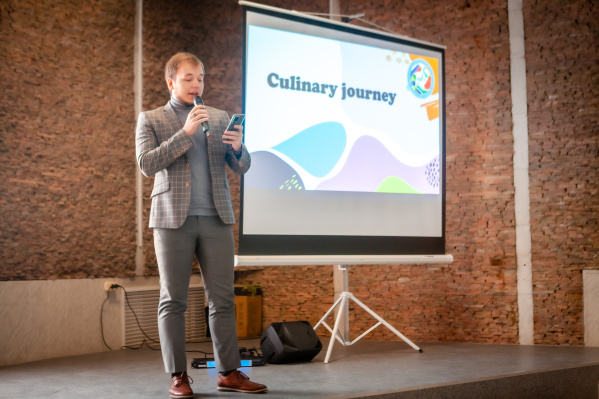Food Festival at INRTU: Corn With Condensed Milk, Royal Kurnik and Noodles With Bean Paste
On December 15, INRTU hosted the Food Festival, an international culinary event featuring European and Asian dishes. The festival was organized by students and staff of the Baikal School of BRICS and the University's Catering Combine.
Second-year student Karim Zhbira from Syria served hearty dinner plates to the guests, accompanied by tonic yerba mate tea. The main set consisted of bulgur, beef, and finely chopped onion cutlets (kibbeh), which paired well with the hot sauce. The student noted that Syrian cuisine is known for its plentiful use of vegetables, grains, and meat.

"Shawarma is popular in Syria, as is tabbouleh, a salad made from bulgur, tomatoes and greens. In my family we like soup with potatoes, rice, chicken and carrots.
I've been living in Irkutsk for three years now and I've had time to try many dishes, but my favourite is borsch with sour cream and bread. In the dormitory, I try what my classmates and neighbours from Indonesia, China and Egypt cook," says Karim Zhbira.
Students from Indonesia surprised the participants and guests of the festival with their national cuisine. The main dish is broth, to which you can add rice, cabbage, potatoes, carrots, boiled chicken or beans soaked overnight. For dessert, Indonesians prefer jasuke, which is made from boiled corn, condensed milk and grated cheese.
The preparatory course graduate Andrian Jehadun came to support his fellow countrymen. In 2011-2012 he studied Russian at INRTU with the aim of becoming a missionary in Russia. During his short time as a student, the Indonesian recalls meeting students from China, Korea, Mongolia and Vietnam. Andrian notes the high quality of education at INRTU. His excellent language training has helped him to serve in the Catholic parish in Chita (Transbaikal region) for more than 10 years.

"The most popular side dish with meat in Indonesia is red rice fried in bamboo stems. Breakfast is sweet, usually banana cake, which each family prepares in their own way. Fresh seafood with various spices is always on the festive table.
During my time in Russia I learned to love shashlik, dumplings and borscht, which I know how to make. I grow vegetables and herbs in the parish garden," said Andrian Jehadun.
Russian cuisine was represented at the festival by kholodets, kurnik, olivier, kisel and dried goods. The true culinary symbol of the country is the kurnik, a ritual cake of ancient Russia, first mentioned in the annals of the 16th century as the favorite cake of Ivan the Terrible. It was made up of an assortment of meats and the Tsar liked to serve it to his noble guests. The dome-shaped pie, which resembled Monomakh's hat, was prepared for weddings and on the Holy Trinity day. It is believed that the kurnik got its name from its main filling. But there is another opinion: the cake was named by the Cossacks because it resembled their dwelling - a round kuren.
Students from Korea cooked chajangmen - noodles seasoned with bean paste. The original recipe adds meat. The dish is popular at graduation ceremonies, when friends and parents are treated to the noodles. Guests could also try rolls wrapped in dried, pressed sheets of seaweed called "kim" and stuffed with steamed rice "pap". In Korea, the kimbap snack is usually taken to school and work.
The Indian students generously seasoned their black tea with milk and sugar with cinnamon, one of the most popular spices in the cold winter season. Each cup had its own unique sweet and spicy flavour, warm and mild aroma. Cloves and aniseeds added to the tea helped to quench the guests' thirst. Green cardamom gave the healthy drink a resinous flavour with a hint of eucalyptus.
Photo by Arseniy Chekmarev














